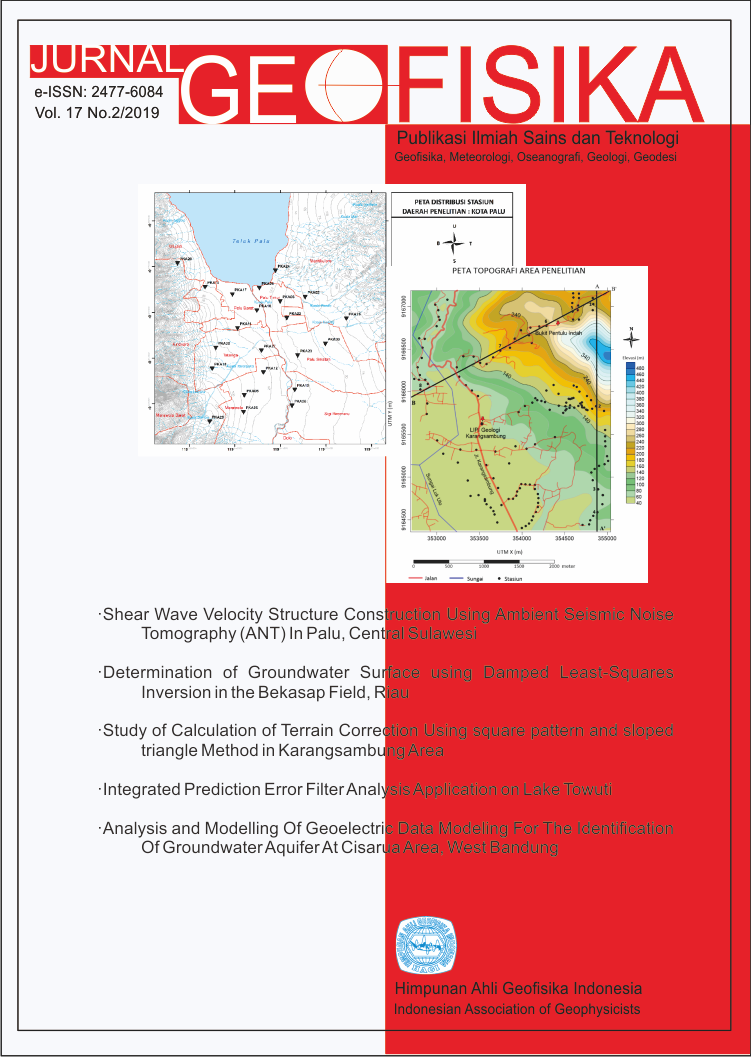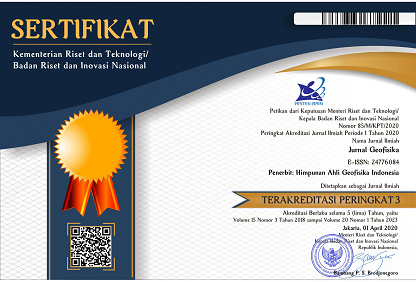Integrated Prediction Error Filter Analysis Application On Lake Towuti
Keywords
Autoregressive Burgs Coefficient, Lake Towuti, INPEFA, OWF, trend removal, Well CorrelationAbstract
Every naturally-occurred phenomenon on earth is related to cyclicity. On a larger scale, it can be defined as the occurrence of climate periodicity which is caused by the revolution of earth towards the sun. It can also be examined on a smaller process such as the days and nights cycles, as the effect of earths rotation. This research will specifically discuss about the cyclicity of grain size changes in sediments from lake Towuti, Indonesia. The cyclicity of the sediments is deduced using Integrated Prediction Error Filter Analysis (INPEFA) trends. The INPEFA trends are used to analyse the probability of sediments distribution by simply calculating the cumulative errors between predicted and actual data. Unlike any other implementation of INPEFA that mainly observing lithology controlled by sea level changes, this research is aimed at applying INPEFA to enhance well correlation process across an area that is strongly influenced by rainfall intensity and some climatically-driven processes. By correlating the sediment units, the lateral distribution of the climatically-driven diatom ooze will eventually help a better understanding of paleoclimate events on lake Towuti. This research is aimed at constructing and applying systematic algorithm on INPEFA logs calcultation. Two main cores that construct the INPEFA calculation are trend removal process and autoregressive coefficients calculation using Burgs method. When dealing with real datasets the trend removal process is an imperative process to prevent ambiguous INPEFA trend. Moreover, the use of trend removal process is also favourable in interpreting INPEFA trends for various cyclicity periods, this is achieved by varying the input parameters on the trend removal process. Autoregressive coefficients calculation on the other hand is the keystone that constructs the INPEFA logs calculation process. Well correlations process is successfully achieved through interpreting the INPEFA trends logs. Validation of the INPEFA logs shows good correlation between the result and core sample from lake Towuti with widely-distributed tephra being the main key validator. The changes in INPEFA trends is interpreted to be linked with the change in grain size and also in sediments impedance. Comparing and validating the INPEFA trends with two seismic traces from the lake reveals that the turning point of INPEFA trends are associated with strong reflection on the seismic traces. We approach the building of pseudo-INPEFA section through applying optimum Wiener filter (OWF) during the multi-attribures analysis. The lateral continuation of predicted pseudo-log was improved, overall correlation showed an increase by 15% and a decreased in error value by 25%.
References
Prabowo, K., Nicholas, J., Winardhi, S. (2011). Enhancing pore pressure analysis through integrated prediction error filter analysis, SEG Annual Meeting Perth 2011.
Soua, M. (2012). Application of Facies Associations, Integrated Prediction Error Filter Analysis, and Chemostratigraphy to the Organic-Rich and Siliceous Cenomanian-Turonian Sequence, Bargou Area, Tunisia:
Integrated Sequence Stratigraphic Analysis, Journal of Geological Research, 22, 1-15.
Russell, J. M., Bijaksana, S., Vogel, H., Melles, M., Kallmeyer, J., Ariztegui, D., Crowe, S., Jannatul Fajar, S., Hafidz, Abd., Haffner, D., Hasberg, A., Ivory, S., Kelly, C., King, J., Kirana, Kartika H., Morlock, M., Noren, A., OGrady, R., Ordoez, L., Stevenson, J., von Rintelen, T., Vuillemin, A., Watkinson, I., Wattrus, N., Wicaksono, S., Wonik, T., Bauer, K., Deino, A., Friese, A., Henny, C., Imran, Marwoto, R., Ngkoimani, L.O., Nomosatryo, S., Safiuddin, L.O., Simister, R., Tamuntuan, G. (2016). The Towuti Drilling Project: Paleoenvironments, biological evolution, and geomicrobiology of a tropical Pacific lake. Scientific Drilling, 21, 29-40.
Huang, J. (2014). Study of autoregressive (ar) spectrum estimation algorithm for vibration signals of industrial stream turbines, International Journal of Control and Automation, 7, 349-362.
Teja, R. V., Rakesh, U., dan Rao S. K. (2017). Spectral analysis of seismic signals using burg algorithm, International Journal of Pure and Applied Mathematics, 114, 163-171.
Vaidyanathan, P. P. (2008). The theory of linier prediction, California Institute of Technology, 198pp.

This work is licensed under a Creative Commons Attribution 4.0 International License.
The copyright of all articles belongs to the authors. All other copyrights is held by the Journal











